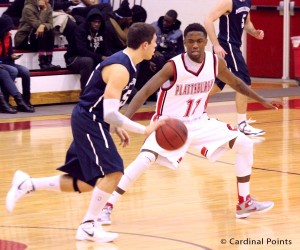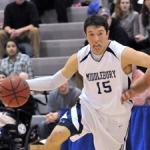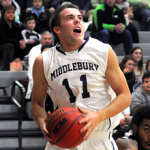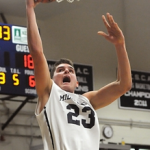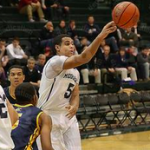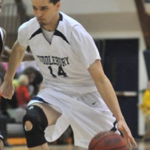January 12, 2014, 4:00 pm
Middlebury (6-5, 0-1) vs. Tufts (6-5, 0-0)
Listen here
Over the past three seasons, there has been a clear cream of the NESCAC crop. Between the 2010-2013 seasons, Middlebury, Amherst and Williams combined for eight top-three finishes and all three conference championships. This year a handful of squads look to crash the championship party, and one team poised to do so is the Tufts Jumbos.
Three years ago the Jumbos were a mediocre squad, going 4-5 in conference, suffering blowouts to the NESCAC’s top teams. The next season, 2011-2012, Tufts improved to 6-4 in conference in a down year for Williams, placing fourth in the league, but still failed to compete with Middlebury and Amherst.
Finally, in 2012-2013, Tufts gave a top team a scare, losing by a point when Middlebury’s James Jensen swatted a last second jumper. The Jumbos’ only conference losses last season came against Middlebury and Williams at home and on the road at Amherst. In their third straight postseason appearance, Tufts again fell to Amherst on the road, 80-64, in the NESCAC Semifinals. They finished the year at 17-9 overall and 7-3 in conference, the most conferences victories for the program since 2004-2005. Tufts is finally putting Titletown on the D3 basketball map (there’s your shameless plug of Boston sports for the week)
Now in his 26th season at the helm of the Jumbos, head coach Bob Sheldon has turned out some impressive recruiting classes over the past decade, which has helped the team reach their current level of relevance. Junior Ben Ferris earned NESCAC Rookie of the Year honors his first season on campus in 2011-2012. That year he tallied 9.6 points per game, 5.1 rebounds per game and 1.3 assists. Last year, as a sophomore, the 6’ 3” guard led the squad in scoring, rebounding, 3-pointers made and steals.
Sheldon’s recruiting prowess continued in 2012-2013 as he brought in the 6’ 8” Massachusetts native Tom Pelleschi to play center. Pelleschi played well early on, but truly emerged once NESCAC play began. While averaging 13.7 points, 6.2 rebounds and 1.9 blocks per game during conference play and shooting at a 57% clip, Pelleschi did enough not only to win NESCAC Rookie of the Year honors (the second straight Jumbo to do so), but also to earn the distinction of D3Hoops.com Northeast Region Rookie of the Year.
Unfortunately, Pelleschi’s career may have come to a sudden end. The dynamic center suffers from an enlarged aorta that will certainly keep him away from the court for the 2013-2014 season and leaves his playing future in significant doubt.
So, the question on the court for the Jumbos at the outset of conference play is how to replace the production of one of the league’s most talented returning centers.
As in the past two seasons, Sheldon has relied on some talented freshman to shoulder a significant load. Only three freshmen will don the baby blue and brown in Medford this year, but two of them stand amongst the league’s tallest. The 6’ 8” Hunter Sabety hails from Oceanside, NY and Drew Madsen, though listed as a 6’ 7” forward, will be among the league’s tallest big men as well. Sabety in particular fits the void left by Palleschi. At 240 pounds, he can bruise underneath but will still bring a good amount of athleticism, and turned down a slew of D1 offers in favor of Tufts. And Sabety has a penchant for winning. As a four-year varsity player and three-year starter, Sabety accrued an 88-33 record and led his high school to a Division 3 State Championship last season. Palleschi has been involved with the team and done his best to bring the young big men along.
Sabety has been everything Coach Sheldon had hoped for and more to start the year. Eleven games into his college career, Sabety is the team’s leading scorer and rebounder despite only playing 20.6 minutes per game, and is a defensive force, racking up 2.3 blocks per game, fourth among NESCAC big men.
The Jumbos frontcourt has been bolstered by the emergence of 6’ 7” senior Tommy Folliard. The Richmond, VA native has more than doubled his scoring from last season, from 5.6 to 12.3, and is a remarkable 21-38 from deep (55%).
Additionally, with a hip stress fracture keeping last year’s leading scorer, Ben Ferris, sidelined until after the new year, 5’ 10” 170 lbs point guard Tarik Smith has logged significant minutes. In 20 minutes per game off the bench, Smith has helped senior Oliver Cohen handle point guard duties and has been deadly efficient from the floor, scoring 10 point per game on 49% shooting and 47% from behind the arc.
Though losing their two men in the middle with the injury to Palleschi and the graduation of Scott Anderson, the Jumbos have returned a dynamic backcourt, where Ferris is joined by sophomore Stephen Haladyna. The 6’5” Haladyna was third on the team in scoring last season, dropping 10.2 per game. What’s more, Oliver Cohen, who logged more minutes than any other returner from last year and led the team in assists, has stepped right back into his point guard role, and leads the team with 5 assists per game. Additionally, the voluntary departure of would-be junior guard CJ Moss, who played over 23 minutes per game last year and started in all 17 of his appearances, put more pressure on the team’s returning guards. Haladyna and Cohen were expected to shoulder the load early on for the Jumbos with the injury to Ferris and departure of Moss, but an injury of his own kept Haladyna to just six games before the new year. The Jumbos have gotten backcourt production from a long list of names, including the team’s second-leading scorer, senior Kwame Firempong, and from sophomore Ryan Spadaford, who’s played under 20 minutes per game off the bench but has racked up over 10 points per game and is shooting above 50%.
In the team’s first game since the break, the Jumbos (6-5) lost on the road to Rhode Island College (7-5). But, the good news for Coach Bob Sheldon is that he finally got a look at the rotation that will carry the Jumbos through conference play, barring further injuries. Haladyna took the court for the first time in weeks, and Ferris for the first time all year, playing 28 minutes. Both showed signs of rust, but there is no question of their ability once they get in a rhythm.
At the season’s outset, the loss of Palleschi seemed like a monstrous void to fill. But with the emergence of Folliard and the instant success of Sabety, accompanied by the legion of experienced and inexperienced guards playing big minutes and producing for the Jumbos, Tufts seems to be rounding into form at the perfect time, before their first conference matchup with Middlebury in central VT. The biggest issue for Tufts thus far has been defense. Though fourth in the league in scoring, Tufts is also fourth-to-last in points allowed. Hopefully for the Jumbos, the return of Ferris will improve their perimeter defense that will have an affect on all other parts of their game. What’s more, if Sabety can refrain from the foul trouble he’s often gotten himself into, he is poised to make a Palleschi-esque leap in terms of production in conference play and potentially earn the Jumbos’ third straight NESCAC Rookie of the Year honor. Tufts will need continued strong play from the frontcourt to complement their guards if they hope to make the team’s first trip to the NCAA Tournament since 2005-2006 and dethrone the triumvirate of Middlebury, Amherst and Williams.
Aaron Liebowitz of the Tufts Daily contributed to this post

